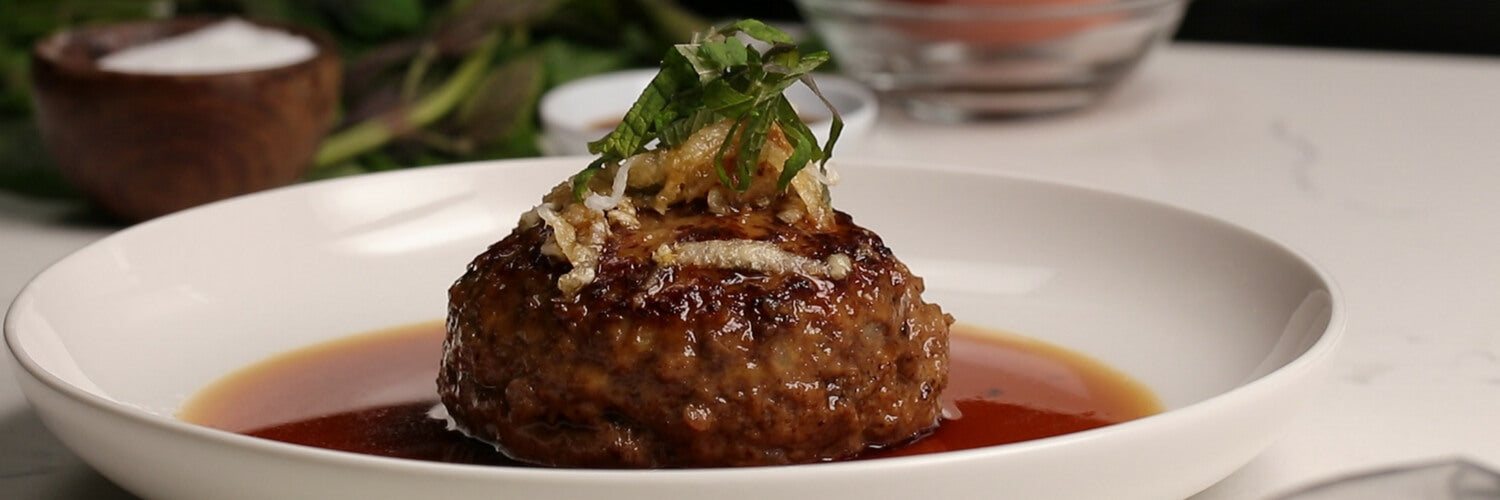
In Japan, we call this hambagu! Juicy teriyaki sauce and the minty flavor of shiso leaves make this dish taste like heaven! Must try if you are hungry.
-Let’s keep the Japanese fusion food rolling! In this unique but easy to follow recipe and video we are going to take the classic Japanese hambagu up a couple of notches in terms of class and flavor. The Japanese-style Salisbury Steak recipe combines the best of authentic Japanese food recipe ingredients with one of America’s favorite dishes. The result is an Asian fusion success that bursts with spice and savory goodness of Japanese flavors like mirin and sake while still providing a filling meal that the whole family will love.
What is Hambagu (Japanese-style Salisbury Steak)?
Japanese hamburger steak, simply called hambagu in Japan, is actually quite popular and widely served in homes at the dinner table. Hambagu is also served at special Western influenced restaurants in Japan called Yoshoku-ya, where you can eat Japanese versions of everything from omelets (omurice) to curry rice. Hambagu is simple to make as it is nothing more than a hamburger patty. You can serve this dish with variety of sauce along with any side dishes you may want. By adding authentic Japanese ingredients to a basic hamburger steak, you get a mouthwatering fusion dish that will wow your guests: the hambagu.
History of the Salisbury Steak
The Salisbury Steak was invented in the United States in the 19th century and is attributed to a physician named James H. Salisbury. A simple bun-less hamburger patty served with brown sauce or gravy and sometimes mashed potatoes, the Salisbury steak is still a staple of many American dinner tables. The Salisbury Steak is similar to several European ground beef dishes including the Hamburg Steak, popular across Germany, and the Swedish Panbiff. Many American restaurants added ground pork to the Salisbury Steak, but in Japan hambagu is usually purely beef.
Hambagu Variety
The recipe here is a classic teriyaki wafu hambagu recipe, but just like omurice, hambagu has many varieties. Hambagu is one of those dishes in Japanese food culture that just keeps evolving new forms. That’s why it is fun to experiment with. Below are just some examples that you can play with at home. Try making different types of Japanese hambagu and find your favorite flavor.
White Sauce:
Red Wine Demi-Glace:
Ketchup Sauce:
Cooking Tips:
- To make juicy hambagu, make the patties thick and steam them with the lid on. This traps the moisture in and keeps the hambagu from drying out.
- If you want to make your hambagu juicier, rest the patty balls in the fridge for about 15 minutes. This allows them to absorb a little bit more water moisture that will later be released as they are cooking.
Japanese-style Salisbury Steak

Ingredients
- Vegetable Oil, for cooking
- 1 cup Water, for cooking
Patty
- 1 lb Ground Beef
- ½ Onions, chopped
- 1 Eggs
- 2/3 cup Panko Bread Crumbs
- 2/3 cup Soy Milk or Milk
- Salt and Black Pepper, to taste
Teriyaki Sauce
- 2 Tbsp Sugar
- 6 Tbsp Soy sauce
- 6 Tbsp Mirin
- 6 Tbsp Sake
- 6 Tbsp Water
- 1 tsp Katakuriko (Potato Starch)
Garnishment
- 1 cup Daikon Radish, grated
- 5 leaves Shiso
Instructions
- Lightly dry the grated daikon radish, thinly slice the shiso leaves, and mix all of the ingredients of the teriyaki sauce in a small bowl.
- In a large bowl, quickly mix the panko and soy milk (or milk) and add the rest of the ingredients of the patty.
- Mix with your hands until the patty turns sticky.
- Once sticky, separate the mixture into 4 parts. Take 1 part and create a thick, circular shape. Make 4 balls in total.
- Pour vegetable oil in a large pan and heat on medium. Place your patties in the pan and bake until crisp on both sides. Try not to push the patties down so the circular shape remains.
- Pour 1 cup of water, place a lid on top, and steam for 5-6 minutes. Take the patties out.
- Quickly wipe the pan with paper towels, and pour in the ingredients of the sauce and mix on low heat until the sauce is thick.
- Place the patties back in the pan, pour the sauce on top, and plate. Put the radish on top, pour the rest of the sauce on top, and add the Shiso leaves. Enjoy!
